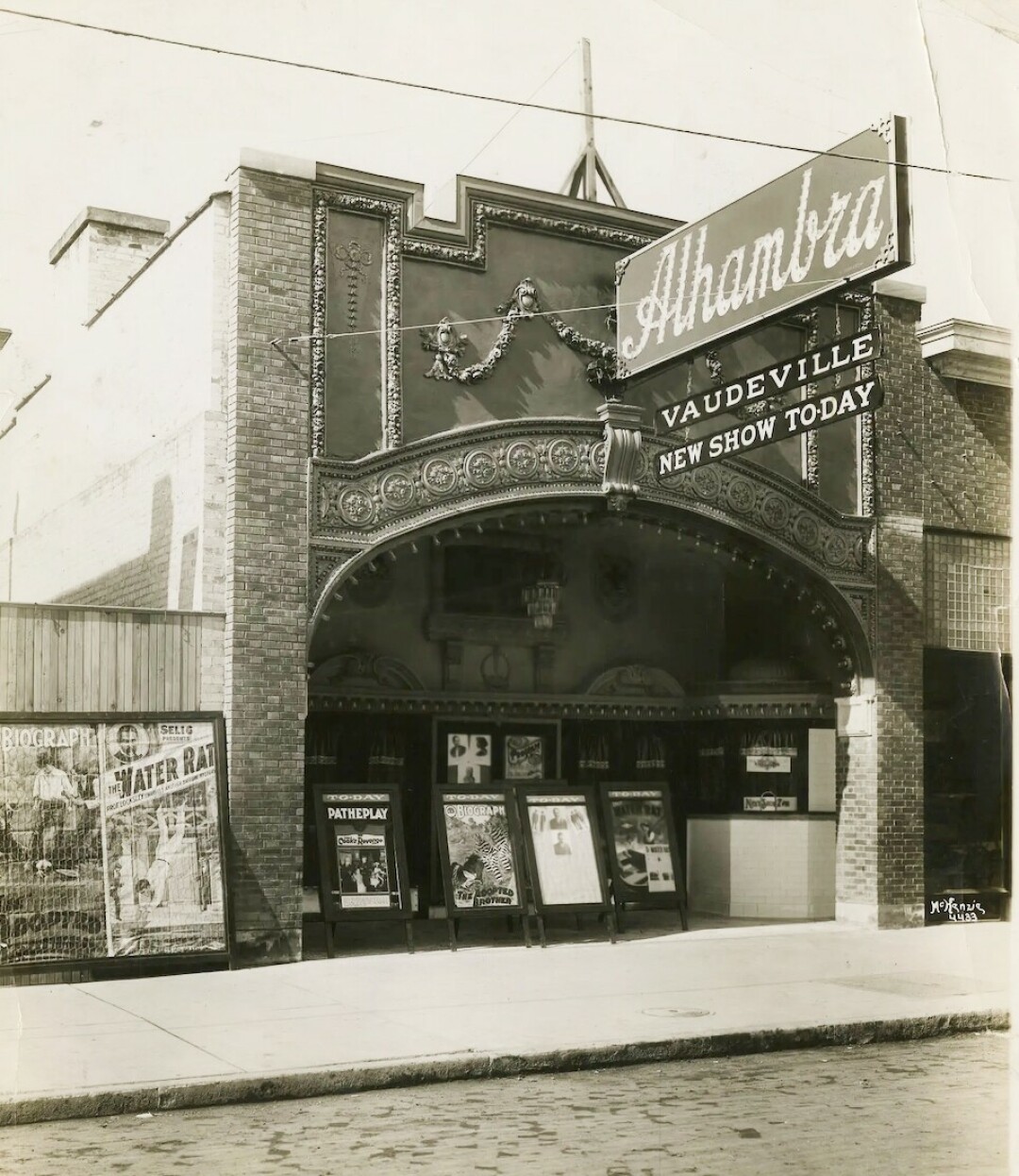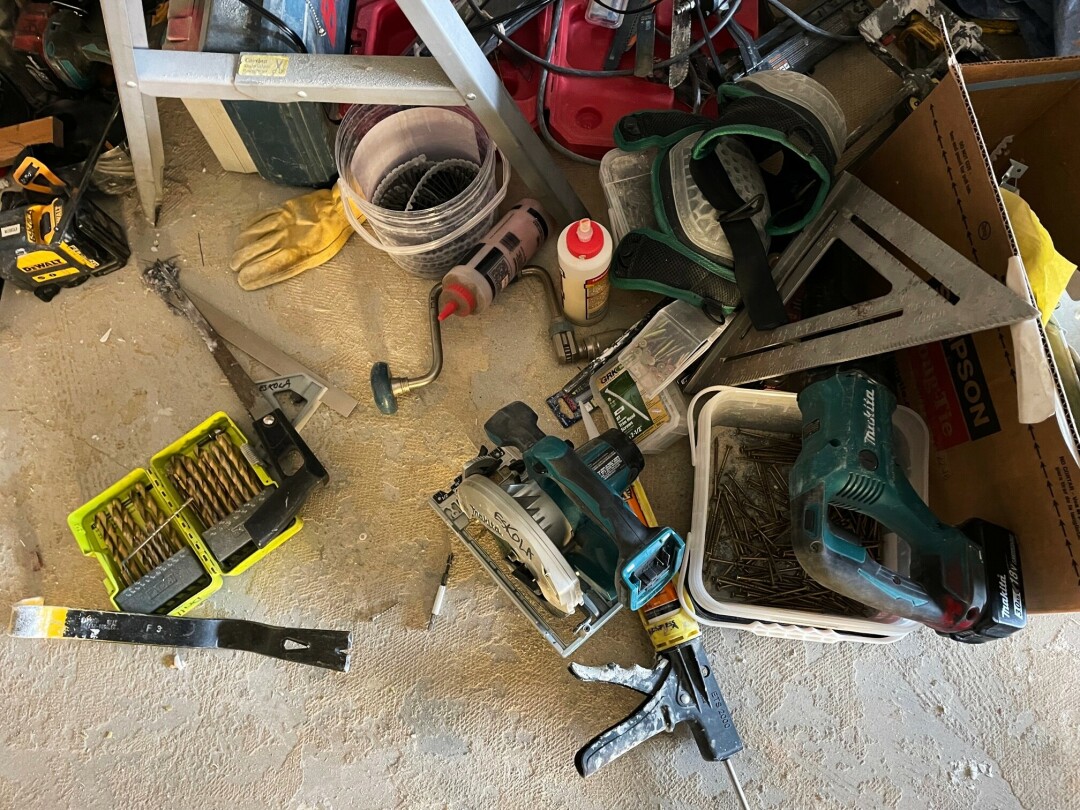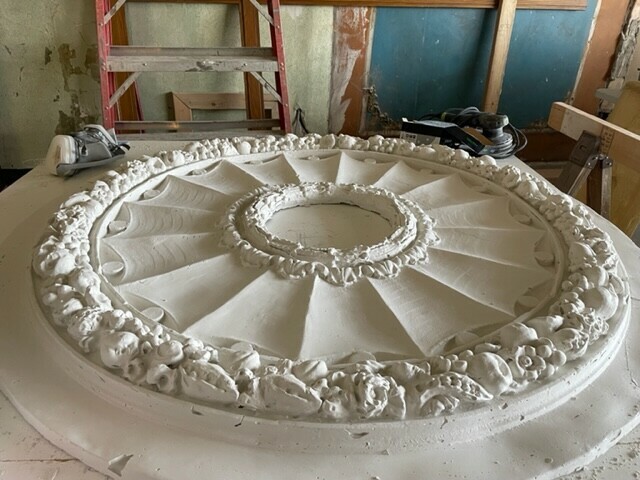The vision for the Alhambra

One of the most exciting West Duluth developments in recent years has been the appearance of a number of classy new establishments. The Boreal House is two years old, Zenith Bookstore five this week. Jade Fountain, also new, has been a welcome addition to the neighborhood where Wussow’s Concert Cafe has served as an anchor for the past two decades.
Across the street the historic West Theater has also contributed to the magic of this neighborhood’s re-emergence. And when Reader publisher Bob Boone completes his current reconstruction project there will be yet another lost historic theater next to the West: The Alhambra.
Located at 321 No. Central Avenue, the Alhambra takes its name from a palace/fortress complex in Granada, Spain. The splendor of Spain’s Alhambra, it’s architecture and its stories, inspired a book by Washington Irving titled The Tales of the Alhambra.
When Bob Boone purchased the West in the summer of 2016, many were surprised. Few imagined such a spectacular result. Today, his enthusiasm for this new project is infectious. Based on his achievement with the West there’s little doubt that his determination and resilience will produce an equally alluring result.
As Virgil wrote in The Aeneid, “Fortune favors the bold.” This statement seems to correspond with the Boone’s unexpected discovery of the long-lost Alhambra precisely next door to the West.
Earlier this month I sat down with the Reader’s publisher to learn more about his vision and some of the backstories around this new chapter in his journey.
The Purchase
Bob Boone’s purchase of the former Alhambra appears to have involved serendipity, an alignment of stars and a pinch of luck.
“While I was in construction on the West, talking with three or four bankers, I said ‘Once we get this finished we’ll need to keep an eye on the Interior Tomato building next door.’ The reason for this was that the West could only expand in one direction. It couldn’t expand on the other side, nor in the back, nor into the street, nor up on the roof or down below the foundation.”
The bankers unsurprisingly replied, “You’re behind schedule on the West. Why are you even considering this?”
Surprisingly, three weeks later the building came up for sale.
Bob acknowledges that he was the worst negotiator ever on this deal.
“The roof leaked. The carpets were trashed. The building was needy.” But he wanted it and knew he needed it.
“When I spoke with one banker, he held up his hand and said, ‘Not now!’ and ran away like his hair was on fire.”
Two days later Paul Persons, owner of the Interior Tomato, a hydroponic gardening supply store, called and said, “I don’t read your paper, but you’re doing good work.”
He then offered a short-term contract for deed with very favorable terms.
A couple days before closing Persons called and said, “I’ve never shown you the building.”
“How old is this building,” Bob asked.
“1913,” Persons replied.
“What was this building?”
“It was a theater. The Alhambra Theater,” Boone was told.
During his tour Boone learned that the original architecture was buried behind hanging ceilings and sheetrock. The building also had steel fireproof doors.
The original Alhambra had a relatively short lifespan, operating as it did in the era of vaudeville and silent movies, which in those days were called photoplay. It was purportedly the last ornate theater built here while Duluth was still booming. Opening in 1913 it ceased operation in 1928. (Trivia: The first “talkie” motion picture, The Jazz Singer, was released on Oct. 6, 1927.)

Financing the Renovation
The dream of restoring the lost Alhambra would involve financing. Boone bought it for $200K, but it was going to take some real capital to finance the renovation. At first, it seemed that $500K would be required, but upon further examination, “so much was intact that I thought it might end up being half that,” Boone said. “Even so, when the bankers found out, they were upset.”
Their biggest concern, and a legitimate one, was that it might distract from the West reconstruction.
So, in July 2018 Boone purchased the Alhambra for $200K on a short-term contract for deed.
Owning a property and renovating it are two separate animals. When the pandemic hit in early 2020, no one wanted to finance a theater project, but Boone got lucky yet again.
When the contract for deed was expiring, Boone got lucky again. “I managed to get a loan to save the building. Bremer Bank swooped in and saved us the day before we would have lost it.”
Lance Reasor, a local businessman involved in various projects, heard of Boone’s plight and reached out.
“I might have an idea,” he said.
As Reasor tells it, “I used to see this young guy struggling in and out of doorways in the middle of winter to get his paper out – midnight, one in the morning, two in the morning. He’s built a successful business and he keeps pushing forward. I admire him for that. He has a vision and doesn’t give up on his vision. I admire his work ethic and his paper.”
Over a lunch meeting with Boone, Reasor began scribbling on a sheet of paper. He then created a plan for a general and limited partnership. He was excited.
“I came up with a plan that I thought would work for him that would put together 17 people,” Reasor recently said. The reason 17 was chosen is that Boone’s Paladin Properties LLC had a target of $170K to complete it at the time.
Bob Boone called his attorney and asked, “Is this legal?”
This plan fell apart due to a technicality. Nevertheless, a variant of the plan did come together. We began seeking lenders, people who would loan us money in 10K increments. We called it The Producers Club.
Reasor immediately committed his $10K.
The Renovation
The proper order for any building renovation is to make sure you fix the roof first. Indeed, it was the first order of business and a new roof was completed. In order to keep costs down, Boone assembled a team of volunteers to help with the interior work. They stripped sheetrock off the walls, removed the suspended ceiling and took on a host of other chores. There have been at least a dozen volunteers involved, many returning as many as 10 times or more.
Because of the ornate nature of the plaster work, Boone called on Curtis Bellows to help return the designs to their original beauty. Bellows said, “It would be the highlight of my career to work on this project.”
With the help of John Erickson, DSGW Architects, they began working out ideas for the theater riser, stage framing and design. No detail would be left to chance.
The Rationale
When Boone purchased the Interior Tomato/Alhambra, his chief aim was to have the ability to expand the West. The presence of a small theater within the new structure proved to be remarkably fortuitous.
This second theater will have a direct impact on the West’s bottom line. Here’s how.
The average theater-goer is unaware of how Hollywood’s film distribution system works or how multiplex theaters came to dominate the industry. When Disney and other major film producers distribute their films, they require theater owners to sign a 20- to 30-page standard contract that stipulates how long you run the film and other specifics about the use of the theater.
The way a multiplex works is that the large theaters show first-run releases, but as viewership tapers off the films get bumped down to the smaller theater spaces. Theaters like the West that don’t have a second or third theater to bump the film down to must run the show for the required amount of time even if the public has lost interest. For theaters like the West this is onerous. There is too much supply for limited demand, yet the contracts don’t make accommodations for single-screen theaters.
According to Boone, “There was a Sundance Institute study that said two-screen theaters do twice as much business as one-screen theaters, and 60% more profit.” In short, the discovery of the second theater was like a godsend.

The Current Vision
After detailing the manner in which the acquisition took place, Boone outlined his plans for the new building. In the rear of the building, which is 25 feet wide and 125 feet deep, will be a 60-seat theater.
An opening will be punched through the wall to connect the West to the Alhambra with the front portion to serve as a lounge and social area.
“Pizza parties for kids during the day, a Roaring Twenties cocktail lounge in the evening,” he said. Boone envisions live music three to four times a week in this part of the building.
In addition to the new entertainment possibilities at the Alhambra, Boone has been making plans to incorporate a full menu of other activities for the West. Some of these include the possibility of a noon family film and streaming events like the Kentucky Derby, concerts and an eclectic mix of film and other special events. A Classic Movie Monday with films like Lawrence of Arabia could be in the cards, and films cherished by smaller audiences with devoted fans.
The pandemic was brutal on theaters. The Marcus Duluth was first to recover, primarily by targeting younger audiences pulled in by Marvel and slasher films.
“Family films are our niche,” Boone said. He anticipates a strong response to his efforts to fill a well-defined entertainment segment.
West Duluth in 1913
As we look at the development of West Duluth today, most of us forget to consider that 100 years ago things were very different with regard to transportation. A 1925 letter to the Duluth Herald complained about there being no theaters in Lakeside. The authors of the letter griped that it took “an hour and over” to drive downtown and back. It would be decades before Highway 35 trampled through.
By way of contrast, although the working-class neighborhoods in West Duluth were equally disadvantaged with regards to getting downtown, they were better served when it came to theaters.
Keep in mind that these were the earliest days of the motion picture industry. Some of the films shown at the Alhambra were produced in Chicago by the Selig Polyscope Company, which produced more than 500 films in its short lifespan. Even though the film industry had not codified its lingo, they did grasp the value of large movie posters for attracting customers.
A Tale of Two Theaters
Boone purchased the West for $140K and restored it for $1.3 million. Compare that to the Norshor, which the city purchased for $2.6 million and required an additional $30 million to restore, which included $7 million from the state.
When Boone finished the West at a cost of 1.3 to 1.4 million, significantly less than what was given to Sherman and Associates, Robin Washington, who was head of the Playhouse board, said to Boone, “I wish we would have had you rebuild the Norshor.”
The project at hand, however, is the Alhambra. Boone does not deny that he had financial assistance while renovating the West. He received a $50K loan from the 1200 Fund. Nevertheless, with all the Build Back Better money that has been sloshing into various local projects, it seems a few sprinkles in the direction of the Alhambra would be immense.
In Mayor Larson’s State of the City address, she noted there has been a lot of new investment taking place. “Last year we had a record number of building permits and a half billion dollars of investment – more than double the previous year and the third year of record investment in a row.”
Though technically not assistance from the city, Boone is eligible to receive a $50K job creation loan from the 1200 Club.
Summing Up
One of the features of the Alhambra in Spain is the remarkable tiling patterns that decorate its interior walls. Islam forbids representations of the human form, thus during the reign of the Moors in Spain we find a decorative kaleidoscope of colorful tiling, carvings and reliefs, more mathematical than representational.
According to John Jaworski, author of A Mathematicians Guide to the Alhambra, the phenomenon that is striking is that there are purportedly only 17 possible pattern combinations, known as tessellations. (For examples, see M.C. Escher.) The standard of 17 exists only in the Alhambra and in Egyptian temples.
What makes 17 an interesting number, besides being an indivisible prime number, is that it is the only known prime number that when cubed is equal to the sum of its digits. Seventeen to the third power = 4913. 4 + 9 + 1 +3 = 17.
Lest this be considered a somewhat tedious digression away from the story, the point here is that there have been some magical elements in the rediscovery, rehabilitation and refinancing of Duluth’s hidden gem, the Alhambra theater. The community will be well served when the Alhambra re-opens its doors in West Duluth.
During our interview Bob Boone gave a big shout out to the owner of Wussow’s across the street.
“Jason Wussow was the brave one,” Boone said when we sat down to talk inside the West’s lobby. “This used to be a blue-collar area. When he opened two decades ago, he turned this area into a destination, creating a hub for this neighborhood.
When the Alhambra is completed and has its grand opening, it will indeed be an event.
If you have lemons, make lemonade
The COVID pandemic nearly destroyed the theater industry. It also negatively impacted traditional refinancing options for the Alhambra’s renovation. Although the West Theatre was the recipient of several generous government loans and grants during the pandemic to secure its future, Bob Boone’s Paladin Properties LLC has needed the assistance of private lenders to help bring his vision for the Alhambra Vaudeville Theatre back to our community.
Because traditional banks have been reluctant to loan to theaters as the pandemic drags on, several community leaders have graciously offered $10,000 loans on the assumption that additional lenders can help move the project forward to the point that the Alhambra may become operational.
Paladin Properties LLC, which owns both the West and the Alhambra. Civic-minded parties are buying shares of a note in $10,000 increments, which fund the renovation project. Contributors are being paid six percent interest, and will be paid off upon refinancing.
Remaining Phase 1 renovations will restore the front half into a usable lounge and install a sprinkler system for the building. The cost for this phase is $110,000.
Phase 2 will restore the back half of the building, and build out and equip the movie theater. This theater can be accessed from the West, and operated by its staff, offering desirable economies of scale. The additional cost for this phase is $90,000.
